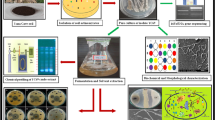Abstract
The effects of podophyllotoxin (PPT), etoposide (VP16), and teniposide (VM26) on the growth of Tetrahymena thermophila BF5 (T.t.BF5) was investigated by the TAM AIR isothermal microcalorimetric system. The extent and duration of toxic effects on T.t.BF5 metabolism were evaluated by studying the growth rate constant (k), inhibitory ratio (I), maximum heat-output power (P max), peak time of maximum heat-output power (t p), and total heat production (Q t). Experimental results showed that the value of t p increased and the value of k and P max decreased with the increasing compound concentrations. Furthermore, the growth rate constant k was linear with compound concentration. The corresponding I was obtained from different k values. According to the IC10 (the concentration of inhibitor when the inhibitory ratio is 10 %), the relative toxicity of the three compounds was PPT (IC10 = 49.6 μg mL−1) > VP16 (IC10 = 117.5 μg mL−1) > VM26 (IC10 = 359.1 μg mL−1). The preliminary investigation of structure–activity relationships showed that the thienyl group was likely responsible for reducing the toxicity of the compounds.




Similar content being viewed by others
References
Muggia FM, Kelley SL. Teniposide in adult solid tumors: a historical perspective. Semin Oncol. 1992;19:43.
Wagner A, Hempel G, Gumbinger HG, Jürgens H, Boos J. Pharmacokinetics of anticancer drugs in vitro. Adv Exp Med Biol. 1999;457:397–407.
Zaman F, Beezer AE, Mitchell JC, Clarkson Q, Elliot J, Davis AF, Willson RJ. The stability of benzoyl peroxide by isothermal microcalorimetry. Int J Pharm. 2001;227:133–7.
Von AU, Wirz D, Daniels AU. Isothermal microcalorimetry—a new method for MIC determinations: results for 12 antibiotics and reference strains of E. coli and S. aureus. BMC Microbiol. 2009;9:106.
Baldoni D, Hermann H, Frei R, Trampuz A, Steinhuber A. Performance of microcalorimetry for early detection of methicillin resistance in clinical isolates of Staphylococcus aureus. J Clin Microbiol. 2009;47:774–6.
Johnson MD, Volker J, Moeller HV, Laws E, Breslauer KJ, Falkowskia PG. Universal constant for heat production in protists. Proc Natl Acad Sci USA. 2009;106:6696–9.
Shen XS, Jin MH, Zhao CX, Tan XQ, Liu HF, Qin XL, Qiu ZP, Liu Y. Microcalorimetric study of the effect of artesunate on the growth metabolism of mitochondria isolated from rat liver. J Therm Anal Calorim. 2013;111:1947–52.
Liu CC, Zhao XB, Yang KW, Xu KZ, Zhai L, Yang X, Gao HZ. Exploring antibiotic resistance based on enzyme hydrolysis by microcalorimetry. J Therm Anal Calorim. 2013;111:1663–7.
Sardaro A, Castagnolo M, Trotta M, Italiano F, Milano F, Cosma P, Agostiano A, Fini P. Isothermal microcalorimetry of the metabolically versatile bacterium Rhodobacter sphaeroides. J Therm Anal Calorim. 2013;112:505–11.
Moura KO, Vieira EFS, Cestari AR. The use of solution microcalorimetry to evaluate chemically modified fish scales as a viable adsorbent for heavy metals. J Therm Anal Calorim. 2012;107:999–1005.
Zheng D, Liu Y, Zhang Y, Chen XJ, Shen YF. Microcalorimetric investigation of the toxic action of Cr(VI) on the metabolism of Tetrahymena thermophila BF5 during growth. Environ Toxicol Pharmacol. 2006;22:121–7.
Braissant O, Wirz D, Gopfert B, Daniels AU. Use of isothermal microcalorimetry to monitor microbial activities. FEMS Microbiol Lett. 2010;303:1–8.
Beermann K, Buschmann J, Schollmeyer E. A calorimetric method for the rapid evaluation of toxic substances using Tetrahymena pyriformis. Thermochim Acta. 1999;337:65–9.
Gonzalez AM, Benitez L, Soto T, De Lecea JR, Gutierrez JC. A rapid bioassay to detect mycotoxins using a melanin precursor overproducer mutant of the ciliate Tetrahymena thermophila. Cell Biol Int. 1997;21:213–6.
Kong WJ, Zhao YL, Xiao XH, Li ZL, Ren YS. Action of palmatine on Tetrahymena thermophila BF5 growth investigated by microcalorimetry. J Hazard Mater. 2009;168:609–13.
Wu YW, Xiao XH, Gao WY, Zhao YL, Jin C, Liu Y. Establishment of a novel preliminary screening model for bioactive parts of folium of Isatis indigotica based on biothermodynamics. China J Chin Mater Med (Chin). 2006;31:676–9.
Long BH, Casazza AM. Structure–activity relationships of VP-16 analogues. Cancer Chemother Pharmacol. 1994;34:S26–31.
Zhang XY, Li WG, Wu YJ, Tian X. Antioxidative and antitumor activity of derivatives of 4-β-amino-4′-demethylepipodophyllotoxin and their structure–activity relationship. Pharmazie. 2007;62:432–8.
Acknowledgements
The authors gratefully acknowledge the financial support of the National Science and Technology Major Project of China (2012ZX10005-005).
Author information
Authors and Affiliations
Corresponding author
Rights and permissions
About this article
Cite this article
Gong, M., Zhang, N., Sun, YQ. et al. Isothermal microcalorimetric investigation of the toxic action of the effective constituents of Podophyllum emodi Wall on Tetrahymena thermophila BF5 . J Therm Anal Calorim 115, 2369–2374 (2014). https://doi.org/10.1007/s10973-013-3314-x
Received:
Accepted:
Published:
Issue Date:
DOI: https://doi.org/10.1007/s10973-013-3314-x




